Control Center repositories contain configurations that can be applied to multiple managed firewalls. Configuration data that are used on more than one firewall should be stored in a repository to save time and reduce configuration errors. The configuration settings are entered only once and then linked to the corresponding configuration nodes on the managed firewall. When you change a setting in a repository object, all linked configuration entries are automatically updated. It is possible to override individual settings of the repository objects. Three types of repositories exist:
- General Repository
- Range Repository
- Cluster Repository
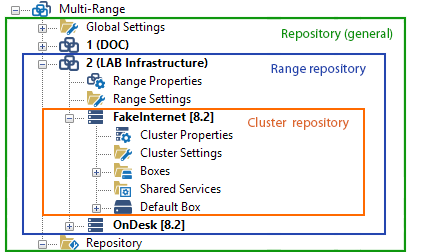
Create a Repository
- Click the CONFIGURATION tab.
In the Configuration Tree, right-click Multi-Range and select Create Repository.
Click Activate.

You can now create new configuration entries or copy existing entries from the Configuration Tree.
Copy an Existing Configuration to the Repository
- In the Configuration Tree, navigate to the configuration node.
- Right-click the configuration node and click Lock.
Right-click the configuration node again and click Copy to Repository.

- Enter a Name for the new repository object and click OK.
- Click Activate.
Link a Configuration Node to the Repository
- In the Configuration Tree, navigate to the configuration node.
- Right-click the configuration node and click Lock.
- Right click the configuration node again and click Link from Repository.
- Select the repository object and click OK.

- Click Activate.
Within the configuration tree, a linked node is marked with an arrow symbol and shows the path behind an arrow-like icon (->).

Migrate a Configuration Node in the Repository
If a repository object has a version prior to the configured firewall, you can update it to a newer version using the migrate function.
- In the Configuration Tree, navigate to the configuration object in the repository.
- Right-click the object and click Lock.
- Right click the configuration node again and click Migrate Node.
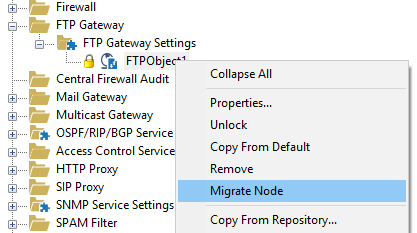
- Select the version from the drop-down list and click OK.
- Click Activate.
Repository Override
Use override to replace firewall-specific settings in a linked configuration.
Step 1. Enable Override for Link
- In the Configuration Tree, navigate to the configuration node.
- Right-click the linked configuration node and and click Lock.
- Right click the configuration node again and click Override Link Data.
- Click Activate.
The arrow-like icon will now be extended by a plus [+] character to indicate that this node houses overrides.

After Override Link Data has been activated, the menu available by left-clicking the icon on the right-hand side of many configuration fields will contain additional entries regarding repository data overriding.
Step 2. Overriding Repository Settings
If you do not want a repository setting to be applied to a CloudGen Firewall unit, you can override it.
To override a specific parameter of the configuration:
- Double-click the configuration entry.
- Click Lock.
- Left-click the blue list icon next to the parameter, and select an override option.
- Enter the new parameter value.
- Click Send Changes and Activate.
Depending on the configuration field type, the configuration section, when locked, offers one or several of the following options:
Override Entry – Boolean or text-type configuration fields offer the option Override Entry. Once activated, manipulation of the entry is not disabled, but may be freely toggled.
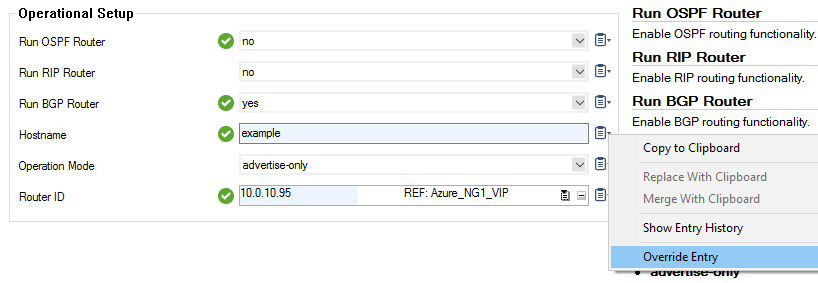
- Strict Override – List-type configuration entries offer two different overriding modes.
- Strict Override (Clear) – The linked configuration data will be cleared on the CloudGen Firewall. Subsequently, it may be filled locally.
- Strict Override (Copy) – Copies the repository data back to the box into the local configuration. Once activated, the list values remain the same. From there, the list may be locally changed or modified by adding new values.
- Merge Override – Section-type entries basically offer the same two overriding methods as lists. In addition, they offer Merge Override. This is the most powerful overriding mode because it enables single configuration items within a section to be locally edited while others remain linked from the repository. Choose Merge Override from the appropriate menu. After Merge Override has been selected, the section entry becomes editable.
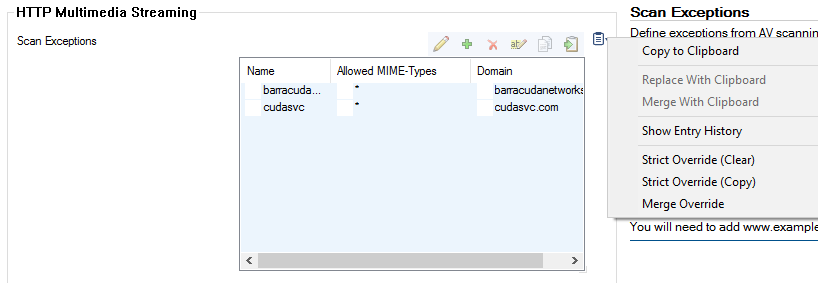
When a new configuration item is added, it appears with an orange file icon on the left side of the name, indicating that this item is locally stored.
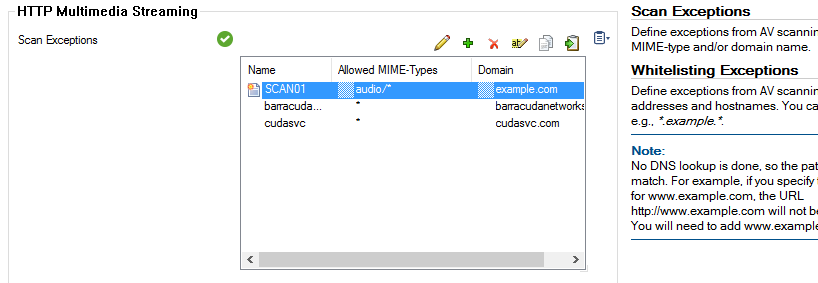
Removing Repository Overrides
To revert to the original data stored in the repository object, select Remove Override. This works on all types of overridden entries.
Removing a Repository Link
To remove a repository link, copy the data from the repository object to the local configuration node.
- Navigate to the configuration node.
- Right-click the linked configuration node and and select Copy from Repository.

Repository Multiple Object Action
To simplify changing the settings for multiple configuration nodes at the same time, you can use the multiple object action for the repository.
- Right-click the repository object.
- Click Lock.
- Right-click the entry again and select Multiple Object Action. The Link Multiple Objects window opens.
- Select the configuration nodes you wish to apply the action to. Use the shift/ctrl keys to chose multiple nodes.
- Expand the Action on Selected Nodes drop-down menu at the bottom of the window, and select the action to be performed.
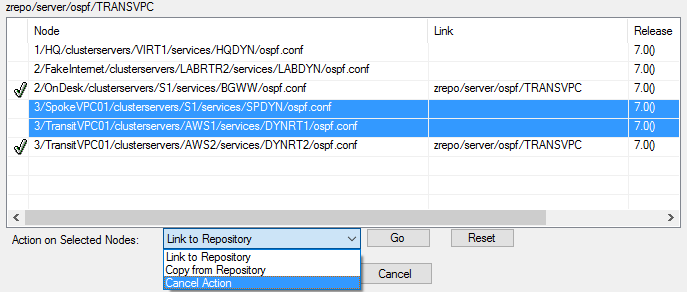
- Click Go.
- Click OK to close the window.
